
http://www.iaeme.com/IJMET/index.asp 457 editor@iaeme.com
International Journal of Mechanical Engineering and Technology (IJMET)
Volume 10, Issue 03, March 2019, pp. 457-465. Article ID: IJMET_10_03_047
Available online at http://www.iaeme.com/ijmet/issues.asp?JType=IJMET&VType=10&IType=3
ISSN Print: 0976-6340 and ISSN Online: 0976-6359
© IAEME Publication Scopus Indexed
THE CENTRAL ROLE OF BUSINESS MODEL
INNOVATION ON FIRM PERFORMANCE IN
THE CREATIVE INDUSTRY
Indrawan Nugroho
BINUS Business School, Doctor of Research in Management
Bina Nusantara University, Jakarta Indonesia
Harjanto Prabowo
BINUS Business School, Doctor of Research in Management
Bina Nusantara University, Jakarta Indonesia
Firdaus Alamsjah
BINUS Business School, Doctor of Research in Management
Bina Nusantara University, Jakarta Indonesia
Mohammad Hamsal
BINUS Business School, Doctor of Research in Management
Bina Nusantara University, Jakarta Indonesia
ABSTRACT
Previous studies on business model innovation were considered to have several
problems specifically related to the clarity of the construct and gaps with antecedents,
contingency and results. Most researches focused on variables outside the
organization as antecedents of business model innovation. This study examines
variables that are within the organization, namely transformational leadership,
innovation culture and information technology as antecedents of business model
innovation and measures their impact on firm performance. The study was conducted
on 196 firms in the creative industry in Indonesia. Structural Equation Model was
used to analyse statistical data. The result shows that transformational leadership,
innovation culture and information technology do not directly impact firm
performance. They need to be mediated by business model innovation.
Keywords: Transformational Leadership, Innovation Culture, Information
Technology, Business Model Innovation, Firm Performance

The Central Role Of Business Model Innovation On Firm Performance In The Creative Industry
http://www.iaeme.com/IJMET/index.asp 458 editor@iaeme.com
Cite this Article: Indrawan Nugroho, Harjanto Prabowo Firdaus Alamsjah, and
Mohammad Hamsal, The Central Role of Business Model Innovation on Firm
Performance in The Creative Industry, International Journal of Mechanical
Engineering and Technology, 10(3), 2019, pp. 457-465.
http://www.iaeme.com/IJMET/issues.asp?JType=IJMET&VType=10&IType=3
1. INTRODUCTION
In recent years, research examining the role of business model innovation on firm
performance has emerged [1-3]. However, analysis on 150 scientific studies related to
business model innovations published between 2000 and 2015 concluded that those studies
had several problems specifically related to the clarity of the construct of business model
innovation and having gaps with antecedents, contingency and the results [4]. In regard to
antecedents, previous researches focused on variables outside the organization as antecedents
of business model innovation, such as competitors' business strategy and environmental
constraints [5], disruptions and increasingly intense global competition [6], shifting of the
basis of competition [7] and unexpected changes to the business environment [8].
Different from those previous researches, this study seeks to examine the variables that
are within the organization, also called internal drivers, namely transformational leadership,
innovation culture and information technology as antecedents of business model innovation
and measure their impact on firm performance. Research on the internal drivers of business
model innovations such as these are still very rarely done [4]. This research was conducted on
196 firms in the creative industry in Indonesia. Creative industry was chosen for its strategic
contribution to the economic growth of a region or country [9-11].
From the point of view of scientific studies, currently researches carried out in the creative
industry are still very few compared to researches in other industrial sectors [12]. In addition,
existing those researches focus more on the role of government policy on the growth of
creative industries [13-17]. Other studies focus on the technical aspects of creative industries,
such as online sales [18], information technology utilization [19], cultural features [20] or
marketing [21]. Hence, this research is expected to contribute to the study of business model
innovation along with its internal drivers and its impact on firm performance in the creative
industry in Indonesia.
2. LITERATURE REVIEW
Transformational leadership is a leadership style where leaders encourage their team members
to give their best efforts in achieving something higher than what they previously set for
themselves [22]. Transformational leadership has positive and significant influence on
employee empowerment and organizational climate that supports innovation [23]. This
influence creates strong cultural consensus that may encourage or inhibit innovation in the
company [24]. Previous study showed that corporate leaders with transformational leadership
style have significant influence on employees' innovative behavior [25]. They trigger
employee creativity both at the individual and organizational level [26].
While previous studies confirm positive influence of transformational leadership on
innovation in the organization [27-28], studies that specifically measured the influence of
transformational leadership on business model innovation were still very few. Some did not
even directly measure both variables [29]. In this study, business model innovation is defined
as the reconfiguration of various activities in the current business model which is new in the
market where the company competes [30].
Innovation culture is defined as a multi-dimensional context that includes the intention to
apply innovation, infrastructure that supports innovation, values and market-oriented

Indrawan Nugroho, Harjanto Prabowo Firdaus Alamsjah, and Mohammad Hamsal
http://www.iaeme.com/IJMET/index.asp 459 editor@iaeme.com
behaviors and the environment to implement innovation [31]. Many studies have shown
positive correlations between organizational culture and radical innovation such as innovation
on business models of the firms [32-33]. Another study showed CEO’s positive perceptions
on the effects of innovation culture that support the process of business model innovation in
their firm [34].
Information technology can be defined as a general terminology that represents software,
hardware, technical information and telecommunications management, applications and tools
used to create, analyse, process, package, distribute, retrieve, store and transform information
[35]. The role of information technology in firms has developed from previously only
focusing on improving efficiency or automation, to becoming an important tool that enables
firms to build flexible business networks between organizations. Hence, firms adopt
information technology at different levels [36]. This level of utilization of information
technology in the firm becomes key that determines the impact of information technology on
firm performance [37].
Empirical study proved that firms that have high information technology capabilities tend
to outperform other firms in terms of profit and other cost-based performance measures [38-
39]. Information technology is indeed a high value contributor to firm performance, but the
level of contribution varies depend on internal and external factors [40]. However, previous
studies also stated that information technology cannot be seen as a magic bullet that
automatically creates competitive advantage but must be seen as a lever for the success of a
firm’s business strategy [36]. Information technology inspires business strategies or the
design of more radical business models [35].
Ordinary technology that is executed using sophisticated business model can produce
greater value for the firm compared to sophisticated technology exploited using ordinary
business models [1]. Business models that have certain level of newness can also improve
firm performance [41]. In short, business model innovation is key to transformational
business growth [2-3]. Although there have been many studies examined the relationship
between business model innovation and firm performance [42-43], no previous study has
specifically examined business model innovation as a mediating variable between the impact
of information technology and innovation culture on firm performance.
3. RESEARCH METHODS
This study is conducted on firms in the creative industry in Indonesia. 309 questionnaires
were distributed to firms from all 16 sub-sectors of creative industry. 196 questionnaires were
deemed useable and have been entered for analysis in SPSS 23.0 and AMOS 23.0. This study
used six anchored Likert scale (1 for strongly disagree to 6 for strongly agree) through self-
administered questionnaire. The questionnaires were filled by firm’s owners or senior level
managers of the firm.
Structural Equation Modelling (SEM) method is used for the analysis of this study.
Goodness of fit test was carried out to check whether the model is truly representing the
population. Validity and reliability test of the questionnaire were conducted. Trimming model
was used to eliminate variables or dimensions that have no significant standardized loading
factors. Lastly, hypothesis testing was carried out on all hypotheses of this study.
4. DISCUSSION OF RESULTS
Testing of the instruments used for this study were conducted on 30 creative industry firms. It
was carried out to see if all indicators used in the instrument were good enough or if revisions
to the instrument were needed to be done by removing or revising the indicators. The result
showed that the instruments used in this study can be considered reliable. The Cronbach's

The Central Role Of Business Model Innovation On Firm Performance In The Creative Industry
http://www.iaeme.com/IJMET/index.asp 460 editor@iaeme.com
Alpha for each measured variable is above 0.7 and for each item, the value of Corrected Item-
Total Correlation is above 0.3. Therefore, this measuring instrument can be used for the actual
sample of the population that was the target of this study.
The goodness-of-fit index produced from testing the measurement model shows the
suitability of the measurement model with data 2 (444) = 715,767; p = 0,000; SRMR =
0.050; RMSEA = 0.056 (90% CI = 0.048 - 0.063) (good fit); TLI = 0.930 (acceptable fit); CFI
= 0.937 (acceptable fit)). A good goodness-of-fit index in this measurement model shows that
all variables in the study are well measured through the measuring instruments used, so that
testing of structural models and hypothesis testing can be done. Figure 4.1 below shows the
measurement model of the research.
Figure 4 1. Measurement Model of the Research
Meanwhile the goodness-of-fit index resulted from testing the structural model (as shown
in figure 4.2 below) also shows the suitability of the measurement model with data (2 (445)
= 727,782 p = 0,000; SRMR = 0.055; RMSEA = 0.057 (90% CI = 0.050 - 0.064) (good fit);
TLI = 0.927 (acceptable fit); CFI = 0.934 (acceptable fit)). Therefore, the structural model
used in this study is considered to have represented the phenomenon to be studied.

Indrawan Nugroho, Harjanto Prabowo Firdaus Alamsjah, and Mohammad Hamsal
http://www.iaeme.com/IJMET/index.asp 461 editor@iaeme.com
Figure 4 2. Structural Model of the Research
There are nine hypotheses proposed in this study. Table 4.1 below lists the hypothesis
and show the results of all hypothesis testing.
Table 4 1 Results of Hypothesis Testing
Hypotheses
B
t-value
LLCI
ULCI
Result
H1: TL IC
0,448*
7,661
0,314
0,599
Accepted
H2: TL BMI
-0,002
-0,014
-0,285
0,254
Rejected
H3: IC BMI
0,714*
3,493
0,211
1,290
Accepted
H4: TL FP
0,109
0,932
-0,183
0,379
Rejected
H5: BMI FP
0,546*
4,825
0,311
0,805
Accepted
H6: IC FP
-0,002
-0,010
-0,731
0,584
Rejected
H7: TL IT
0,588*
7,602
0,416
0,753
Accepted
H8: IT BMI
0,374*
4,645
0,231
0,549
Accepted
H9: IT FP
0,117
1,332
-0,075
0,310
Rejected
*p<0,001
The results of hypothesis testing show that transformational leadership has a positive and
direct impact on innovation culture. This is consistent with previous studies that showed
transformational leadership proved to be able to trigger employee creativity both at the
individual and organizational level [6]. A similar conclusion was also made in other studies
[23-25]. However, transformational leadership does not play a direct role in business model
innovation. This test result does not conflict with previous researches. Previous researches did
not specifically measure the influence of transformational leadership on business model
innovation, but rather attributes that are similar to transformational leadership [26] or that are
similar to business model innovation [27-28].
The result of hypothesis testing also indicates that transformational leadership does not
play a direct role on firm performance. There might be three reasons for this. First, the
conditions of the creative industries in Indonesia are unique and different from the industries





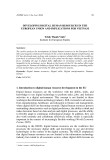
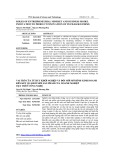
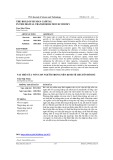
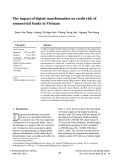
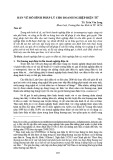
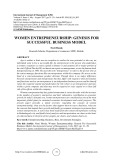

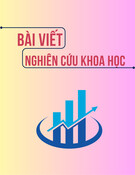










![Bộ câu hỏi trắc nghiệm Đổi mới và sáng tạo [mới nhất]](https://cdn.tailieu.vn/images/document/thumbnail/2025/20251007/kimphuong1001/135x160/56111759828894.jpg)


